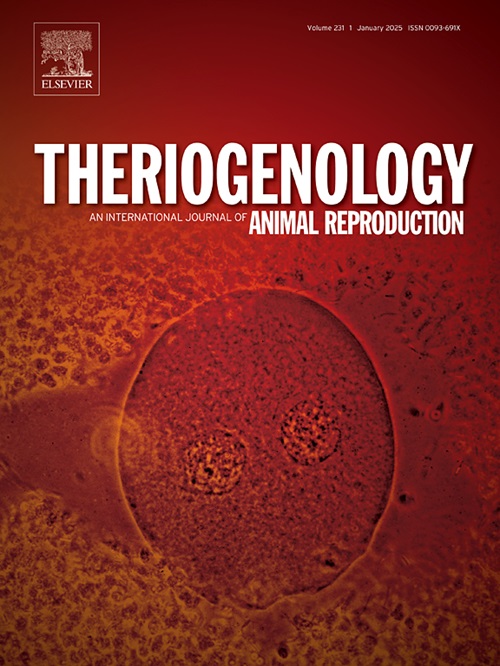犬脓脓症中FOXP3+ T细胞与免疫失调
IF 2.4
2区 农林科学
Q3 REPRODUCTIVE BIOLOGY
引用次数: 0
摘要
犬脓脓是一种与免疫失调有关的化脓性子宫感染。本研究探讨了调节性T细胞(Tregs)及其相关因子在犬子宫脓积累中的作用。16只客户拥有的完整母狗,其中8只被诊断患有脓膜肿大,另外8只健康的动物正在接受选择性卵巢子宫切除术。采集血样于乙二胺四乙酸(EDTA)包被管中进行流式细胞术检测。在卵巢子宫切除术后获得组织样本,用于检测作为Treg功能关键调节因子的白介素(IL)-2和IL- 2r α的定位。采用逆转录定量聚合酶链反应(RT-qPCR)分析基因表达。流式细胞术分析结果显示,子宫组织中Tregs数量显著增加,外周血中Tregs数量相应减少。这种转变可能反映了脓膜瘤中treg从外周血向蜕膜的募集。子宫组织IL-2表达明显上调。Tregs产生的抗炎细胞因子(如IL-10)和效应T细胞分泌的促炎因子(如rorγ - T和IL-17A)表达异常,这为犬脓脓症免疫功能障碍的机制提供了更深入的认识。综上所述,这些观察结果阐明了犬子宫脓膜增生过程中Tregs及其相关因素的动态变化,从而为子宫免疫微环境的平衡提供了新的视角。本文章由计算机程序翻译,如有差异,请以英文原文为准。
FOXP3+ T cells and immune dysregulation in canine pyometra
Canine pyometra is a suppurative uterine infection associated with immune dysregulation. This study investigated the role of regulatory T cells (Tregs) and associated factors in the pus accumulation within the canine uterus. Sixteen client-owned intact bitches, eight diagnosed with pyometra and the other eight healthy animals undergoing elective ovariohysterectomy, were enrolled. Blood samples were collected into ethylenediaminetetraacetic acid (EDTA)-coated tubes for flow cytometry. Tissue samples were obtained after ovariohysterectomy and used to examine localization of interleukin (IL)-2 and IL-2Rα as key regulators of Treg functions. Gene expression was analyzed by reverse transcription quantitative polymerase chain reaction (RT-qPCR). Results of flow cytometry analysis revealed a significant increase in the population of Tregs in the uterine tissue and their corresponding decrease in the peripheral blood. This shift is likely reflective of the recruitment of Tregs from the peripheral blood to the decidua in pyometra. There was a marked upregulation in the expression of IL-2 in the uterine tissue. There was dysregulation in the expression of anti-inflammatory cytokines produced by Tregs (such as IL-10) and pro-inflammatory factors secreted by effector T cells (such as RORγt and IL-17A), which gave a deeper insight into the mechanism underlying the immune dysfunction in canine pyometra. Taken together, these observations elucidate the dynamic changes in Tregs and related factors during canine uterine pyometra, thus providing a new perspective on the equilibrium of the uterine immune microenvironment.
求助全文
通过发布文献求助,成功后即可免费获取论文全文。
去求助
来源期刊

Theriogenology
农林科学-生殖生物学
CiteScore
5.50
自引率
14.30%
发文量
387
审稿时长
72 days
期刊介绍:
Theriogenology provides an international forum for researchers, clinicians, and industry professionals in animal reproductive biology. This acclaimed journal publishes articles on a wide range of topics in reproductive and developmental biology, of domestic mammal, avian, and aquatic species as well as wild species which are the object of veterinary care in research or conservation programs.
 求助内容:
求助内容: 应助结果提醒方式:
应助结果提醒方式:


